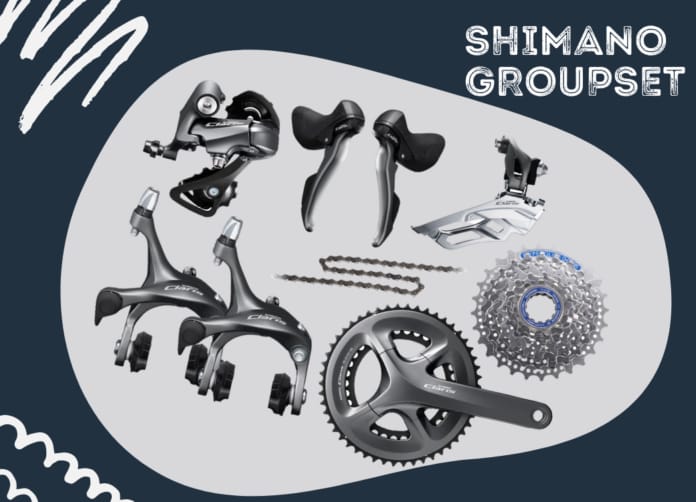This is Part 2 of my Beginner’s Bike Buying Guide series for someone doing their first 70.3 or Ironman.
Part 1 gave an overview of entry considerations, where to buy, brands, sizing and more.
In this I’ll cover:
bike components
group set
pedals and cleats
bike accessories
What Are Bike Components?
A bike’s components are all the parts that make the bike move forward (and make it stop).
Technically every single part of the bike (frame, handlebars, seat, etc.) can be included here, but we’ll keep it simple and cover:
Groupset
Pedals and Cleats
What Is A “Groupset”?
A bike’s “groupset” includes the cassette, chain, crank, derailleurs, shifters and breaks (all pictured below).

Most bike repairs and part replacements will be on the groupset.
Shimano is by far the most common brand you will find. They have 3 main product hierarchies:
Shimano 105: these are basic-level and what you will find on nearly every entry level road bike
Shimano Ultegra: these are mid-level, provide smoother gear shifting than the 105 and are usually on bikes in the $4k+ price range
Shimano Dura-Ace: these are high-level, have automatic shifting and other bells and whistles that put bikes with Dura-Ace in the $7k+ price range
If you’re considering a used bike that does not have Shimano 105 (or higher), it’s a good idea to have your local bike shop take a look before you buy for 2 reasons:
It’s inevitable that you’ll need component parts replaced over time
You want a group set that your local shop can easy find replacement parts for, maintain, etc.
Pro Tip: other groupset brands typically compare to a Shimano model.
Understanding Pedal & Cleat Options
When I bought my first road bike, I was shocked it didn’t come with pedals.
And I was in pure disbelief that it didn’t even have a kick stand!!
Since buying a new bike means you’ll also be buying pedals, it’s important to have a grasp on pedal and cleat options.
Especially since cleats wear over time and you’ll need to replace them every year or so.
Pedals and cleats are 2 puzzle pieces that have to match.

LOOK’s main road bike pedal/cleat product name is “Keo” and Shimano’s is “SPD.”
If you have a Look Keo pedal, any of the Keo cleats below will work.
If you have a Shimano SPD pedal, any of the SPD cleats below will work.
LOOK cleats do not clip into Shimano pedals and Shimano cleats do not clip into LOOK pedals.

*SPD product names are listed as “SM-SH#”
*Float refers to how much lateral wiggle room there is when the cleat is clipped in
My preferred combo: Look KEO pedals and Keo Gray cleats
A note on cleats that clip into Peloton and indoor spin bikes: Pelotons use LOOK Delta pedals and cleats.
While they look very similar to Keo, LOOK’s Delta cleats do not clip into LOOK Keo pedals.
A note on mountain bike pedals and cleats: Mountain bike pedals work on road bikes, but they’re not optimal.
They’re heavier and designed to limit mud accumulation and make unclipping quicker.
Road riding doesn’t need to worry about these things.


Bike Accessories
Here are the accessories you’ll want to add on your bike (and that you’ll need to ride):
On the bike:
Pedals
Safety light
Water bottle cages
Saddle bag with flat repair kit
Aero bars (see Part 3)
On your person:
Helmet
Bike shoes (with cleats)
Miscellaneous:
Bike tire pump
Your local bike shop should have all of this, but it’s worth searching online if you’re looking to save.
Summary:
Bike “components” are all the mechanical parts that make the bike move forward and come to a stop
The components most important to maintain make up the bike’s “groupset”
Shimano 105 is the entry level groupset and what you’ll find on most bikes
Pedals are purchased separately from new bikes and have specific cleats that match
The 2 most common pedal/cleat options are Look KEO and Shimano SPD
Mountain bike pedals work on road bikes, but they’re not optimal
Accessory list
Covered in Part 1:
entry considerations
where to buy a new or used bike
road bike vs. tri bike
help finding your frame size
brands I recommend
Coming in Part 3:
3 ways to upgrade your road bike for triathlon
my 70.3 road bike set up
